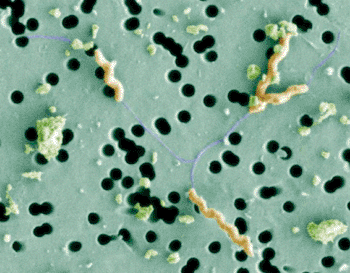Membrane Filters Compared for Isolation of Campylobacter
By LabMedica International staff writers
Posted on 18 Jul 2013
Several isolation methodologies have been developed for Campylobacter spp., and in order to have an effective isolation of C. jejuni and C. coli from feces, the culture media must be selective.Posted on 18 Jul 2013
Some species of Campylobacter, like C. concisus, as well as Arcobacter spp. may be susceptible to the antibiotics in the modified Charcoal Cefoperazone Deoxycholate Agar (mCCDA) media, and the diagnosis may consequently be missed if a passive filtration technique is not performed.

Image: Filter Electron Microscopy of Campylobacter jejuni (Photo courtesy of Louise Salt).
Microbiologists at the Aalborg University Hospital (Denmark) evaluated the filtration technique by comparing two different filters, a polycarbonate (PC) membrane filter and a cellulose acetate (CA) membrane filter for isolation of Campylobacter spp., especially C. concisus. The study was conducted from February 2012 until June 2012, and 1,791 diarrheic stool samples from 1,377 patients were cultivated for enteric pathogenic bacteria.
Fecal samples were applied to two filters, a PC filter with a diameter of 47 mm and a 0.60-μm pore size (Nuclepore, Whatman; Maidstone, Kent, UK), and a CA filter with a diameter of 50 mm and a 0.65 μm pore size (Sartorius AG; Gottingen, Germany). Each filter was placed on the surface of a 5% yeast-enriched blood agar plates (SSI [Statens Serum Institut] Diagnostica; Hillerød, Denmark). After filtration, the filters were carefully removed with sterile forceps and discarded and the culture plates were incubated at 37 °C.
C. jejuni and C. coli were the only species of bacteria that grew on the mCCDA medium. The scientists found a significantly higher prevalence of 114 C. concisus with use of the PC filter compared to 79 with the CA filter, even though the PC filter had a smaller diameter as well as a smaller pore size. The authors concluded that the filtration technique should not be used as a replacement for the mCCDA, but that their results imply that the filtration technique works well for the isolation for all Campylobacter spp. They found that the filter technique easy to handle in the routine laboratory and recommend the use of the PC filter instead of the commonly used CA filter when culture for Campylobacter is performed. The study was published on June 3, 2013, in the journal Diagnostic Microbiology and Infectious Disease.
Related Links:
Aalborg University Hospital
Whatman
Sartorius AG














